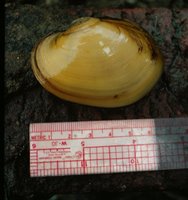 Last July, two naturalists canoeing on the Connecticut River found the first Yellow Lampmussel identified in the state since 1961. Once common and widespread, this mollusk was a source of food, currency, and jewelry for the American Indians. Colonists ate the meat and made buttons from the shells, whose interiors are lined with mother of pearl.
Last July, two naturalists canoeing on the Connecticut River found the first Yellow Lampmussel identified in the state since 1961. Once common and widespread, this mollusk was a source of food, currency, and jewelry for the American Indians. Colonists ate the meat and made buttons from the shells, whose interiors are lined with mother of pearl.In nature, lampmussels help filter the water of both good and bad substances. They are also food for River Otters and other small mammals, as well as fish.
The Yellow Lampmussel succumbed to the activities of man, particularly polluting, damming, and dredging. The fact that they are being rediscovered here and in neighboring states, says the Connecticut Department of Environmental Protection, is a sign that the health of at least some rivers is improving.
We can do our own part in creating healthy waterways by eliminating – or at least carefully using – pesticides, fertilizers and other chemicals on our yards. Remember, say environmental officials, “what you put on the land will eventually end up in our rivers.”




No comments:
Post a Comment